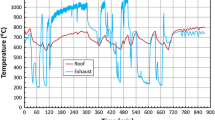Abstract
Holding furnaces use less energy than melting furnaces but still represent an important process to optimize in the aluminum industry. Given that less energy is used, low-cost changes are needed to cost justify any furnace or burner work. Further modeling on a holding furnace was done to examine and investigate the optimum design to reduce energy usage. This paper investigates different options, e.g. burner size and load, chimney location and height, and furnace length and height. Preliminary results indicated a significant increase in the exergy efficiencies and therefore gas saving when the optimum selection of burner size, chimney location and furnace length/height is considered.
Access this chapter
Tax calculation will be finalised at checkout
Purchases are for personal use only
Similar content being viewed by others
References
C. Belt, “Current State of Aluminum Melting and Holding Furnaces in Industry”, JOM, 11 (2015), 2690–2695.
A. Brimmo and M. Hassan, “Furnace Modeling for Efficient Combustion Gas Circulation”, Light Metals 2016 (TMS, 2016), 757–761.
M. Hassan and A. Brimmo, “CFD Comparison of Immersed Heater and Open Fire Burner Designs for Casting Furnaces”, Light Metals 2015 (TMS, 2015), 915–920.
C. Belt, B. Golchert et al, “Industrial Application of DOE Energy Savings Technologies to Aluminum Melting,” Light Metals 2006 (TMS, 2006), 881–885.
STARCCM+ , version 12, Accurate and Efficient Multidisciplinary Technologies in a Single Integrated User Interface, SIEMENS Inc., 2017.
MI Hassan, S Alshehhi, C Belt, “Gas Fired Holding Furnace Modeling for Efficient Operation,” - Light Metals 2018 (TMS, 2018), 1049–1055.
F.P. Incopera, D.P. Dewitt, T.L. Bergman and A. Lavine, Fundamentals of Heat and Mass Transfer, Hoboken: John Wiley and Sons, 2007.
M. Moran, H. Shapiro, D. Boettner, M. Bailey, Fundamentals of Engineering Thermodynamics, 7th Ed., Hoboken: John Wiley and Sons, 2011.
Author information
Authors and Affiliations
Corresponding author
Editor information
Editors and Affiliations
Rights and permissions
Copyright information
© 2019 The Minerals, Metals & Materials Society
About this paper
Cite this paper
Hassan Ali, M.I., Alshehhi, S., Belt, C. (2019). Aluminum Holding Furnace Optimal Design Using the CFD Method and Factorial Approach. In: Chesonis, C. (eds) Light Metals 2019. The Minerals, Metals & Materials Series. Springer, Cham. https://doi.org/10.1007/978-3-030-05864-7_141
Download citation
DOI: https://doi.org/10.1007/978-3-030-05864-7_141
Published:
Publisher Name: Springer, Cham
Print ISBN: 978-3-030-05863-0
Online ISBN: 978-3-030-05864-7
eBook Packages: Chemistry and Materials ScienceChemistry and Material Science (R0)




